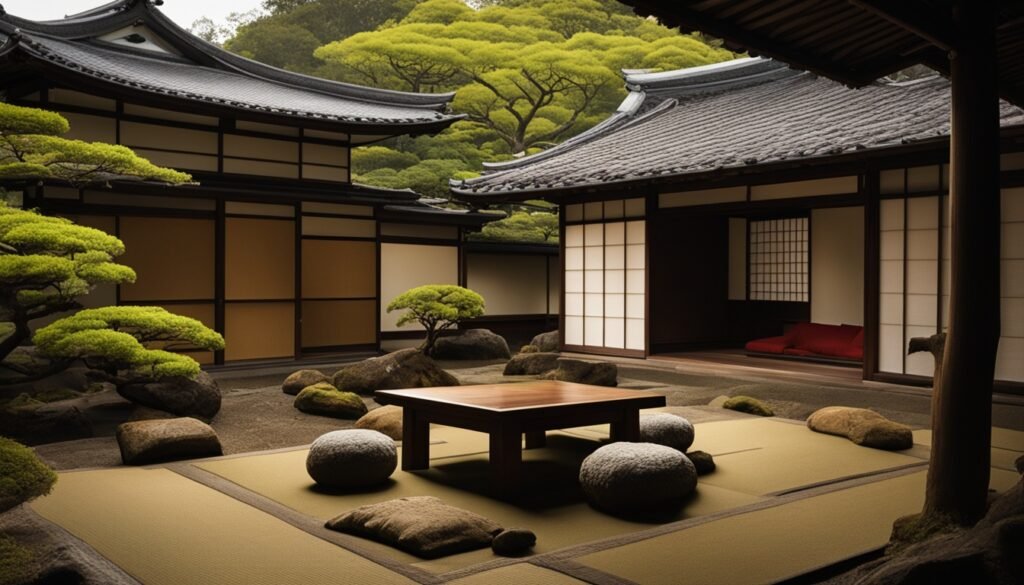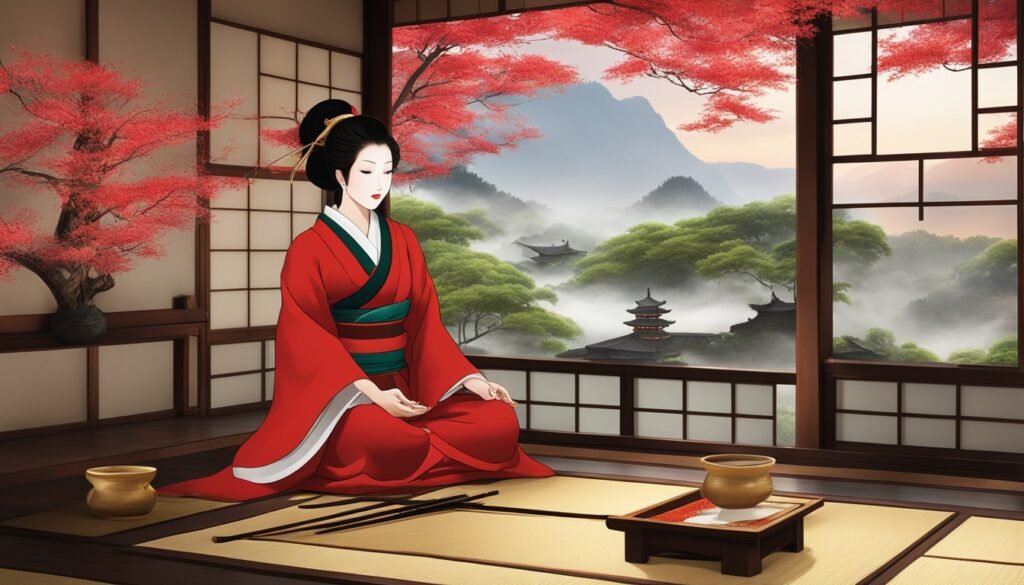Table of Contents
Picture yourself in a peaceful, elegant setting. Here, the ancient practice of tea-making is alive, filled with history and tradition. Are you interested in diving into Japan’s tea culture? You’re about to discover something remarkable. So, where do these genuine tea ceremonies take place in Japan?
The Japanese tea ceremony, also known as chanoyu or sado, dates back for centuries. It’s rooted in Zen Buddhism, focusing on simplicity, respect, and love for nature. Sen no Rikyu (1522-1591) is credited with refining it into the spiritual practice we know today. His changes turned the ceremony from a simple get-together into a deeply meaningful event. This tradition remains very important in Japanese culture.
Today, people all over the world come to Japan to experience this unique cultural aspect. In Tokyo, for example, you can find various ways to enjoy tea. There are tea ceremony experiences, modern tea houses, afternoon tea, and tea shops all around.
Understanding the Japanese Tea Ceremony Tradition
The Japanese tea ceremony, or chanoyu, dates back to 815. That’s when monk Eichu brought tea preparation from China for Emperor Saga. The emperor was so impressed that he started tea plantations in western Japan. Though, it wasn’t until the 12th century that tea became popular all over Japan.
Origins and History of Chanoyu
The tea ceremony is deeply connected to Zen Buddhism. It focuses on simplicity, respect, and enjoying nature. Sen no Rikyu (1522-1591) elevated the tea ritual. He made it more than a social event, turning it into a spiritual and refined practice.
Principles and Philosophies Behind the Tea Ritual
At the ceremony’s core are harmony, respect, purity, and tranquility. These principles, inspired by Zen Buddhism, shape every part of the ceremony. The host’s precise movements, utensil choices, and seasonal decorations all symbolize these values.
The tea ceremony goes beyond being just social. It’s a deep, spiritual practice. It links people to nature, teaches the value of now, and focuses on being mindful. This approach has kept the traditions and philosophies of the ceremony alive for centuries. Today, it still deeply interests people all over the world.
Key Elements of a Traditional Tea Ceremony
In Japan, the tea ceremony is a revered tradition. Its heart is the tea house known as chashitsu. This structure has tatami-mat floors and a simple, natural design. It prepares the setting for the ancient ritual.
The Tea House (Chashitsu)
The chashitsu uses simple design with materials like wood and bamboo. These evoke a calm and thoughtful space. The floor hearth, ro, allows the host to prepare tea with care over charcoal.
Minimal decorations, such as scrolls or flowers, highlight four key principles. These are harmony, respect, purity, and peace—essential to the tea ceremony.
Tea Utensils and Implements
The tea ceremony involves several important tools, each with a special role. For instance, the chawan (tea bowl), chasen (bamboo whisk), and chashaku (tea scoop) have deep meaning. The host uses these items with great care, showing respect and precision.
Roles and Etiquette
Etiquette is crucial in the tea ceremony. The teishu, or host, carefully prepares and serves the tea. Guests, or chakō, observe and partake with respect.
This involves how they sit, handle tea bowls, and perform specific movements. All actions are part of a detailed and respectful tradition.
| Key Elements of the Tea Ceremony | Description |
|---|---|
| Tea House (Chashitsu) | A purpose-built structure with tatami-mat floors and a hearth for preparing the tea. |
| Tea Utensils and Implements | Specialized items used during the ceremony, such as the tea bowl, whisk, scoop, and water container. |
| Roles and Etiquette | Strict protocols governing the host’s and guests’ responsibilities and interactions. |
Different Styles and Schools of Tea Ceremonies
The Japanese tea ceremony, known as chanoyu or sado, includes many styles and schools. Each has its own unique traditions. The actions in a tea ceremony might differ a bit, but they share common elements.
When guests arrive, they take off their shoes. They are led into the tea house’s waiting room. There they are greeted with a quiet bow from the host. Then, they purify themselves at a stone basin by washing their hands and rinsing their mouths.
Inside the tatami-mat room, guests are asked to notice the hanging scroll or flowers. They admire the attention to detail in these decorations.
All ceremonies follow Zen Buddhist principles. They create a peaceful and thoughtful vibe. This allows everyone to really get into the moment. But, the way tea is brewed and served changes with each tea school.
You can choose an old, very formal tea ceremony, or a newer one. Exploring different styles and schools of Japanese tea ceremony is a rich experience. It shows the deep and captivating traditions loved around the world.
Where can I experience traditional tea ceremonies in Japan?
Kyoto is Japan’s ancient capital and a hub of traditional culture. It’s a top spot for the classic tea ceremony experience. There, visitors can find tea houses in temples, gardens, cultural sites, and some hotels. These places offer chances to take part in the ancient tea ritual.
Renowned Tea Houses in Kyoto
In Kyoto, places like Kiyomizudera and the tea house at Rokuanren offer unique tea ceremonies. The stunning Nijo Castle also has a tea room in its Ninomaru Palace. This room highlights the beautiful design of a traditional tea house.
Tea Ceremony Experiences in Tokyo
Tokyo is another great place for tea ceremonies. The Edo-Tokyo Museum holds them daily. Or, visitors can head to Happo-en garden for a calming tea time with a view of the city.
Other Notable Destinations for Tea Rituals
Other than Kyoto and Tokyo, Japan offers tea ceremony spots like Kanazawa, a historic city by the sea. It’s famous for the Kenroku-en garden’s tea house. Kamakura, south of Tokyo, lets visitors join tea ceremonies at its temples and shrines. This helps connect with Japan’s deep cultural roots.
Preparing for Your Tea Ceremony Experience
Joining a Japanese tea ceremony, also called chanoyu or sado, is a deep dive into culture. It’s not just a sip of tea; it’s a journey. To truly enjoy this experience, you need to know the basics. This includes what to wear and how to act polite. Doing so will make your tea time both respectful and fun.
What to Wear and Bring
In some tea gatherings, like the very traditional ones, wearing a kimono is a good idea. But not every place will expect this level of formality. Before you go, check what’s needed. It’s usually safe to choose clothes that are clean, not too flashy, and comfy. This helps a lot when you’re sitting on the floor in the way the Japanese do, called the seiza position.
You might also need to bring a small present for the host. This could be a pretty flower that fits the season or a yummy Japanese sweet. These gifts show your respect for the hosting tea master.
Understanding the Etiquette
There are certain rules to follow at a tea ceremony. When you get there, take off your shoes at the door. Inside, you’ll most likely sit on the floor in the seiza way. This shows you’re attentive and respectful during the whole event.
It’s very quiet in a tea gathering. Guests should watch the host carefully. Talking is kept to a bare minimum. Enjoy the beauty around you, like the flowers and calligraphy. This adds to the special feeling of the ceremony.
Learning the Art of Tea Ceremony
Tea schools across Japan offer courses on the tea ceremony. These teach the exact steps and art appreciation. Many young women in Japan find value in learning the tea ceremony. It’s seen as a way to show respect, grace, and good manners.
Tea Schools and Courses
If you’re new or have some experience, tea schools are great. They offer everything from basics to in-depth study. Through workshops or long-term programs, you’ll find something that fits what you want to learn.
Becoming a Tea Master
But, just taking classes won’t make you a tea master. It takes lots of practice and deep study. Becoming a master means understanding the spiritual side of the tea ceremony. Schools and courses help you start this important journey.

Modern Interpretations and Innovations
The Japanese tea ceremony stays true to its core principles over the years. But, it has also welcomed changes that modern times bring. Some tea houses and practitioners mix modern design with tradition. Yet, they keep the important parts of the ritual alive. This makes the tea ceremony more appealing to both locals and visitors looking for a blend of old and new.
In Tokyo, the Tsurui-ryu Tea House stands out as a great example. Since 1973, it has mixed old practices with fresh ideas in a beautiful way. People there can experience a traditional tea ceremony in a simple, stylish space. This space uses basic materials and a hint of today’s trends.
Many tea masters are also finding new ways to keep the tea ceremony interesting. They keep the ceremony’s heart while adding new methods and ingredients. Modern interpretations and innovations in Japanese tea ceremony led to adding local and seasonal items. They also try new tea types and ways to brew. This keeps the ceremony attractive to a broad audience.
Japan’s tea culture pleases those who love tradition and those looking for new experiences. By mixing modern interpretations and innovations with ancient traditions, the tea ceremony reflects Japan’s rich heritage. It remains a unique cultural treasure, attracting people worldwide.
Cultural Significance and Preservation Efforts
The Japanese tea ceremony is one of Japan’s top three arts, along with incense and flower arranging. It’s linked with Zen Buddhism and shows key Japanese values, like harmony, respect, purity, and tranquility.
The cultural significance of the Japanese tea ceremony is huge. It’s a tradition still alive today, thanks to generations who have kept it. This practice highlights Japan’s deep history and love for the arts. Efforts to keep the tea ceremony alive have been constant. Many cultural groups and experts work to make sure this important tradition doesn’t fade, appealing to people from all over the world.
The tea ceremony is rich in symbolis. No detail is too small, from the tea house design to the precise steps in the ceremony. Things like using natural materials, focusing on the season, and promoting mindfulness make every tea ceremony special. It’s a practice where every part has a deep meaning.
With the world changing fast, Japan faces big hurdles in keeping its traditions. To make sure the tea ceremony lives on, there are special learning programs and events. These help pass on the art to younger people, keeping its elegance and cultural importance alive.

Planning Your Tea Ceremony Adventure
Incorporating a tea ceremony into your Japan trip can be very rewarding. It lets you deeply immerse in Japanese culture. Whether you pick Kyoto’s famous tea houses, Tokyo’s ceremonies, or other spots in Japan, do your homework early. This secures your spot and lets you enjoy the tradition fully.
To truly experience a Japanese tea ceremony, planning is key. Many well-known tea houses and cultural sites open their doors. Make sure to confirm dates and availability ahead of time. For a more personal touch, consider a private or small-group tea session.
Learn the etiquette and customs to enjoy the ceremony more. Knowing the importance of the tea house, the tools, and the host’s role adds to the experience. Go with respect and an open heart. This way, you can dive deep into the tranquility and rich culture the ceremony offers.



